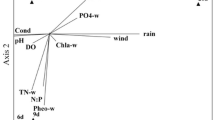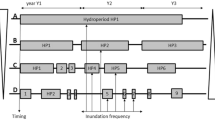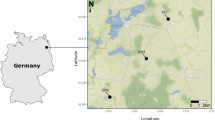Abstract
Most temporary pond zooplankton species produce drought-resistant eggs that accumulate in the sediment and form an egg bank. When a pond dries and the egg bank is exposed, wind erodes eggs and wind action has been suggested as an important determinant of population demographics. While field observations suggest that egg bank erosion may be highest shortly after pond drying and physical disturbance of the sediment crust, this remains to be tested empirically. We performed a laboratory wind tunnel experiment to assess the effects of wind speed and sediment characteristics on egg pickup rates over time in a controlled environment. We used sediment samples in which an egg bank of the fairy shrimp Branchipodopsis wolfi was embedded and compared the number of eggs that blew away from dry, drying and disturbed egg banks as a function of time. Few eggs were picked up when the egg bank was dry prior to exposure, even at winds of 70 km h−1. Most eggs were eroded when the egg bank was exposed to wind before it dried out, after the last water evaporated. Likewise, physical disturbance resulted in strong erosion fluxes. Overall, our results suggest that the state of the egg bank may be more important for egg bank erosion rates than the prevailing wind speed or the wind exposure time. Also, our findings are worrying in the context of climate change since they imply that predicted increases in drying events and reduced inundation lengths may compromise egg bank persistence in temporary ponds.



Similar content being viewed by others
References
Altermatt F, Pajunen VI, Ebert D (2008) Climate change affects colonization dynamics in a metacommunity of three Daphnia species. Glob Change Biol 14:1209–1220
Bilton DT, Freeland JR, Okamura B (2001) Dispersal in freshwater invertebrates. Annu Rev Ecol Syst 32:159–181
Brendonck L (1996) Diapause, quiescence, hatching requirements: what we can learn from large freshwater branchiopods (Crustacea:Branchiopoda:Anostraca, Notostraca, Conchostraca). Hydrobiologia 320:85–97
Brendonck L, De Meester L (2003) Egg banks in freshwater zooplankton: evolutionary and ecological archives in the sediment. Hydrobiologia 491:65–84
Brendonck L, Riddoch BJ (2000) Egg bank dynamics in anostracan desert rock pool populations (Crustacea : Branchiopoda). Archiv Hydrobiol 148:71–84
Brendonck L, Pinceel T, Ortells R (2017) Dormancy and dispersal as mediators of zooplankton population and community dynamics along a hydrological disturbance gradient in inland temporary pools. Hydrobiologia 796:201–222
Caceres CE, Soluk DA (2002) Blowing in the wind: a field test of overland dispersal and colonization by aquatic invertebrates. Oecologia 131:402–408
Evans MEK, Dennehy JJ (2005) Germ banking: bet-hedging and varlable release from egg and seed dormancy. Q Rev Biol 80:431–451
Gillette D (1978) A wind tunnel simulation of the erosion of soil: effect of soil texture, sandblasting, wind speed, and soil consolidation on dust production. Atmos Environ 12:1735–1743
Graham TB, Wirth D (2008) Dispersal of large branchiopod cysts: potential movement by wind from potholes on the Colorado Plateau. Hydrobiologia 600:17–27
Hairston NG, Van Brunt RA, Kearns CM, Engstrom DR (1995) Age and survivorship of diapausing eggs in a sediment egg bank. Ecology 76:1706–1711
Horváth Z, Vad CF, Ptacnik R (2016) Wind dispersal results in a gradient of dispersal limitation and environmental match among discrete aquatic habitats. Ecography 39:726–732
Moss B (2012) Cogs in the endless machine: lakes, climate change and nutrient cycles: a review. Sci Total Environ 434:130–142
Pietrzak B, Slusarczyk M (2006) The fate of the ephippia - Daphnia dispersal in time and space. Pol J Ecol 54:709–714
Pinceel T, Vanschoenwinkel B, Brendonck L (2013) Flexible dispersal dimorphism in zooplankton resting eggs: an example of repeated phenotypic coin flipping? Biol J Lin Soc 110(4):749–756
Pinceel T, Vanschoenwinkel B, Brendonck L, Buschke F (2016a) Modelling the sensitivity of life history traits to climate change in a temporary pool crustacean. Sci Rep 6:29451
Pinceel T, Brendonck L, Vanschoenwinkel B (2016b) Propagule size and shape may promote local wind dispersal in freshwater zooplankton-a wind tunnel experiment. Limnol Oceanogr 61:122–131
Pinceel T, Buschke F, Weckx M, Brendonck L, Vanschoenwinkel B (2018) Climate change jeopardizes the persistence of freshwater zooplankton by reducing both habitat suitability and demographic resilience. BMC Ecol 18:2
Rivas JA, Schröder T, Gill TE, Wallace RL, Walsh EJ (2019) Anemochory of diapausing stages of microinvertebrates in North American drylands. Freshw Biol 64:1303–1314
Stoks R, Geerts AN, De Meester L (2014) Evolutionary and plastic responses of freshwater invertebrates to climate change: realized patterns and future potential. Evol Appl 7:42–55
Tuytens K, Vanschoenwinkel B, Waterkeyn A, Brendonck L (2014) Predictions of climate change infer increased environmental harshness and altered connectivity in a cluster of temporary pools. Freshw Biol 59:955–968
Vanschoenwinkel B, Gielen S, Vandewaerde H, Seaman M, Brendonck L (2008) Relative importance of different dispersal vectors for small aquatic invertebrates in a rock pool metacommunity. Ecography 31:567–577
Vanschoenwinkel B, Gielen S, Seaman MT, Brendonck L (2009) Wind-mediated dispersal of freshwater invertebrates in a rock-pool metacommunity: differences in dispersal capacities and modes. Hydrobiologia 635:363–372
Vanschoenwinkel B, Seaman MT, Brendonck L (2010) Hatching phenology, life history and egg bank size of a fairy shrimp (Branchiopoda, Crustacea) in relation to the ephemerality of its habitat. Aquat Ecol 44:771–780
Williams DD (2006) The biology of temporary waters. Oxford University Press, Oxford
Acknowledgements
The authors would like to thank Geert Neyens for constructing the wind tunnel and for his technical assistance throughout the experiments. TP is supported by a postdoctoral fellowship with the Research Council—Flanders (FWO 12F0719N). This study received additional funding from the Excellence Center financing on ‘Eco and socio-evolutionary dynamics’ (PF/10/007) of the KU Leuven Research Fund.
Author information
Authors and Affiliations
Contributions
TP, BV and LB designed the study. TP and MW performed the experiments, analyzed the data and drafted the manuscript with subsequent feedback from BV and LB.
Corresponding author
Additional information
Publisher's Note
Springer Nature remains neutral with regard to jurisdictional claims in published maps and institutional affiliations.
Handling Editor: Télesphore Sime-Ngando.
Rights and permissions
About this article
Cite this article
Pinceel, T., Vanschoenwinkel, B., Weckx, M. et al. An empirical test of the impact of drying events and physical disturbance on wind erosion of zooplankton egg banks in temporary ponds. Aquat Ecol 54, 137–144 (2020). https://doi.org/10.1007/s10452-019-09731-2
Received:
Accepted:
Published:
Issue Date:
DOI: https://doi.org/10.1007/s10452-019-09731-2




